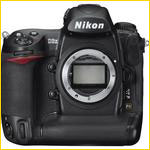
I am convinced that by just about any measure (except price) this is the most outstanding 35mm format DSLR yet. Build quality, image quality – you name it. No, it’s not the fastest shooting, and no it doesn’t have cleanest high ISO capability of any Nikon – its sister the D3 wears that crown. But other than with these specialized capabilities there’s hardly a camera on the market that can touch the Nikon D3x in overall goodness – except when it comes to price.
Did I mention price? At US $8,000, and a lot more in many other countries, the D3x is the most expensive DSLR on the market by far, and is only exceeded in price by medium format cameras and backs. I’ll have more to say about the price issue shortly, as well as my field experience with the D3x in Antarctica, but first let’s digress into a discussion of digital camera size.
______________________________________________________________
The History of Big – and Where Do We Go From Here?
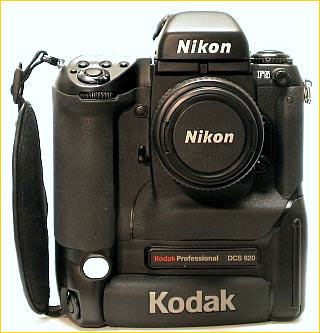
Kodak DCS 620 circa 1999
In the late 1990’s Kodak built the forerunners of today’s pro DSLRs. These included the 2 Megapixel DCS 620 and subsequent models such as the 6 Megapixel 760. The earliest Kodak pro DSLRs had electronics modules attached the way accessory motor drives used to be. But by the time of the DCS 620 Nikon F5 bodies were being modified with integrated electronics so as to be a one piece camera. This lead to the Nikon D1 of 1999, Nikon’s first DSLR of their own design and the progenitor of today’s pro body designs.
There were Canon 1 Series based models as well. A history of Kodak’s early pro digital cameras, the ones that started it all, can be foundhere.
The reason that these new bodies were as large as they were was not because anyone particularly wanted them to be that bulky and heavy, but because they needed to be. It was simply impossible to put all of the electronics and required batteries needed to build and support a digital SLR in a body as "small" as a Nikon F5.
It’s for this reason that we have cameras like the current Nikon D3 series and Canon 1 Series. Kodak, in its final foray into DSLR building, with its DCS-14n of 2003, tried to shrink the full-frame camera, but it really wasn’t until the Canon 5D of 2005 that we had, for the first time, a traditional sized 35mm camera with a full frame sensor. The 5D was a breakthrough both in terms of price and resolution, not to mention just size. But, it wasn’t a "pro" level camera, in that it lacked features and build quality suitable for that designation, though many pros have used them successfully for the past three years.
Then just a few months ago, in Q3 2008, Nikon introduced the D700, offering almost all of the goodness of the large flagship D3 in a traditional sized body. Pro build quality, full frame sensor, identical image quality to the D3, and moderate price. What was not to like?
The mold had been broken. What Canon began with the 5D, Nikon now finalized. It was no longer necessary to build a large camera with integrated vertical grip to be able to provide top build and image quality.Optional vertical grips with additional batteries fill the bill nicely for those that require extra shooting speed, more juice, or different handling.
Which brings us to the new Nikon D3x, Nikons latest state-of-the-art pro level camera. With its almost 25 Megapixel full-frame sensor and tank-like body it offers everything that photographers might want in a camera, except for small size, light weight and low price.

Lamar Channel, Antarctica. January, 2009
Nikon D3x with 24-70mm f/2.8 @ ISO 200
Logically a D700x should follow, but when and at what price? The differential between the D3 and the D3x (identical cameras except for their sensors) is some $4,000. In other words, at $8,000 the D3x is almost exactly double the price of the D3. It doesn’t take a mathematician to figure out that Nikon is therefore charging a $4,000 premium just for its sensor alone. The D700, as of February, 2009, is selling for about $3,000. That means that the premium that Nikon is charging for the D3 over the D700 is just $1,000, and therefore a D700x would have to sell for about $7,000. Not likely.
Here’s the quandary then. Nikon isn’t alone. The competitive 21 Megapixel Canon 1Ds MKIII is selling for about $6,500, but more to the point the new 21 Megapixel Canon 5D MKII and 25 Megapixel Sony A900 are each selling for just $3,000, the same price as a 12 Megapixel D700, and both are regular sized cameras, with optional vertical battery grips available.
If you’ve followed the above somewhat twisted tale certain conclusions are in escapable. The $4,000 premium that Nikon is charging for the sensor in the D3x isn’t likely to drop that quickly. Semiconductor pricing tends to decrease over time due to improved yields, and these are predicated on increased production. Based on anecdotal industry reports it’s clear that D3x’s are not exactly flying off the shelves, and this is caused in no small measure by the worst economic slump in 70 years, which unfortunately for Nikon coincided almost exactly with the release of the D3x.
I should hasten to point out that the Canon 1Ds MKIII, the D3x’s direct competitor, is probably not doing much better. Yes, it’s some $1,500 less than the Nikon, but it already faces a sibling that’s half the price offering image quality that’s comparable, if not even somewhat better since the 5D MKII’s sensor is of a new generation.
Now, compound this with the appearance of the Sony A900 at about the same time as the Nikon D3x. It’s also a full frame 25 Megapixel camera at nearly a third of the cost of the D3x; $3,000 vs $8,000. And, as is widely known, and admitted by Nikon, the sensor used by both cameras is essentially the same fundamental device. (Yes, I know that there’s a lot of proprietary Nikon goodness in their version of this chip, but it does use the same die).
So, here’s the bottom line to this conundrum. Nikon is charging a $4,000 premium for the sensor in the D3x, yet Sony is selling their top-of-the-line A900 camera, which contains a very competative sensor, for just $3,000. What’s wrong with this picture (no pun intended)?
Before the Nikon fanboys burst a blood vessel I will stipulate here and now that the sensor in the D3x is better than the one in the A900. This is so in one area at least, and that’s high ISO. Beginning at ISO 800 one definitely has to give the advantage to Nikon, as seen in my Dec, 2008 three-way noise comparison. Other aspects of image performance are not as clear cut, but it’s not my purpose here to do such a comparison or nit pick the differences between the sensors.
Now, as 2009 begins, we have the following situation. Nikon themselves have created a dichotomy between their previous top-tier pro camera the D3 and the slightly newer D700. Same sensor, same weather sealing, pretty much the same features, yet in a smaller, lighter and less expensive body. It’s really hard to make a case for the D3 now that the D700 is here.
On the other hand they have pressure from their competitors as well. No, the Canon 5D MKII and Sony A900 are not the same robust mega-featured super-hero as the D3x, but neither is too shabby when it comes to the basic job of producing very high quality images in a wide range of shooting situations.
With the 5DMKII Canon finds itself somewhat in the same boat, though they have not emulated Nikon in producing a camera that matches the 1Ds MKIII in terms of build quality and features (yet!).
As I read the tea leaves, here’s where we stand, or I should say, here’s where the camera makers stand. I predict that the days of theuber-cameraare numbered. Bodies the size, weight and price of the Nikon D3 series and Canon 1 series were necessary at one point in time, and that point has now stretched forward to the extent that some in the industry are seeing its horizon. In fact I am convinced that Nikon and Canon themselves see this coming.
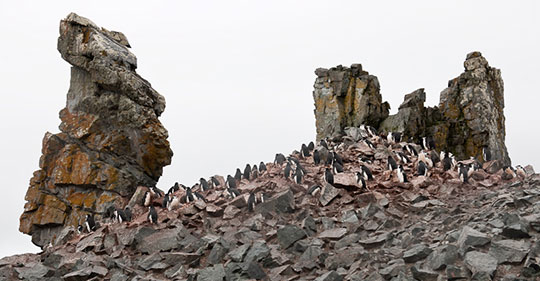
Penguins on the Rocks. Half Moon Island. South Shetlands. January, 2009
Nikon D3x with 24-70mm f/2.8 @ ISO 200
The D700 was not produced as a mistake. Nikon knew full well that it would cannibalize sales from the D3, but also knew which way the winds were blowing. If industry scuttlebutt is to be believed the Canon 5DMKII is flying off the shelves; this at a time when we’re in dark days financially and all retail sales are in the dumpster. If retailers that I’ve spoken with are reflective of the industry in general the Canon 1D MKIII and 1Ds MKIII, on the other hand, are mostly languishing on dealer’s shelves.
So – why would Nikon produce the D3x now, and especially priced the way it is at this point in history?
My theory is as follows. For the past couple of years Nikon has been on a tear to regain its crown. Beginning with the 1D back in 2001 and then the full-frame 1Ds in 2003, Canon eclipsed Nikon in sensor size and resolution and thus bragging rights at least to being the leading pro brand, a title which Nikon had long held. But after an internal management reorganization in the mid-2000’s Nikon came roaring back in short order with the D3, D300, D700, and a range of exceptional new lenses.
Is the D3x then"a bridge too far" price-wise , as I’ve previously called it? Maybe so, but I feel that there’s method to Nikon’s madness. One just has to look at the F6 camera to appreciate some of what is behind Nikon’s thinking. Who else but Nikon would produce a brand newfilmSLR in 2004? Who but Nikon would produce cameras like its limited edition SPrangefinderfilm camera in 2005?
Excepting possibly only Leica, Nikon has a sense of its place in history like few other companies. Unlike some large corporations who are simply motivated by market share and the bottom line, Nikon actually cares about its perceived role in photography. The company thus appears to sometimes make product decisions based on more than financial considerations. So, when it comes to the D3x, what we are seeing may well be a corporate statement by Nikon, much as was made with the F6.We’re back in the game, and we don’t give ground in any market segment.
As for the pricing of the camera, (although they couldn’t have foreseen the full strength of the economic downturn) all I can assume is that Nikon never intended the D3x to be a competitive camera price-wise, but simply a model that they needed to produce to complete their product line and return to greatness.
______________________________________________________________
What Next?
Looking over the horizon 2009 is going to be a fascinating year. Leica has already announced the S2 camera line, a hybrid between a DSLR and medium format – bigger chip, but not that much bigger body and a range of new very high-end lenses designed specifically for digital, with no legacy baggage.
And what about medium format? Hasselblad dramatically dropped its prices in Q4 of 2008, and the other camera and back makers in this category are following suit. While offering markedly different feature sets, how does an $8,000 Nikon DSLR compete with a $10,000 Hasselblad or Phase One 645?
I hope that I have raised more questions than I’ve answered, for one simple reason – I don’t have any answers, just speculation and conjecture. As for the Nikon D3x itself, I recently just returned from shooting with it in Antarctica for a few weeks. I worked with the otherwise identical (other than resolution) Nikon D3 for a year prior, including major shoots such as the one last September inBotswana. These are truly remarkable cameras, possible the finest DSLRs yet, from any company.
______________________________________________________________
D3x on Location
I was very pleased when Nikon Canada came through with a D3x loaner just a couple of days before leaving my for Antarctica. But I had already committed to field testing quite a lot of other gear so this particular camera didn’t get the love on this trip that it might have if it had featured more prominently in my equipment planning. (At that late date I only had room for one Nikon lens, while for the A900 I had packed six, and a second body which made lens swapping easier).
Frankly, with the exciting 60 Megapixel Phase One P65+ back available for me to shoot with, the D3x seemed a bit less exciting than it otherwise might have been. And a few months of shooting with the Sony A900, which shares having a 25MP sensor with the the D3x, tended to diminish the excitement as well. I’m just being honest, not in any way trying todisthe D3x.
Operationally the D3x is almost identical to the D3, which I have been using with considerable pleasure and success for the past year or so. Of course the sensor is 25MP not 12MP, and the shooting speed is commensurately slower, a maximum of 5FPs in 12 bit mode, and less than 2 FPS in 14 bit mode. More on this in a moment.
Otherwise, there isn’t really that much to write about the D3x (excepting its sensor) that hasn’t been said a hundred times in various reviews about the D3. Nikon definitely has an edge over Canon when it comes to features and functionality. A full-featured Auto-ISO capability, proper mirror lock-up, and a dozen or more niceties demanded by photographers make it a real pleasure to use – sort of. But, the lack of sensor dust cleaning is a definate minus in 2009.
The counterpoint to lots of features is a dense user interface that requires some getting used to. Sometimes quickly accessing a feature that isn’t often used can become an exercise in frustration. I don’t really have a suggestion for Nikon in this area as they have handled the menu structure about as well as anyone else. It’s just that there are so many customizations possible that finding what you want can become a bit of aWhere’s Waldoexercise. Remember when cameras had aperture rings, shutter dials and….that was about it!
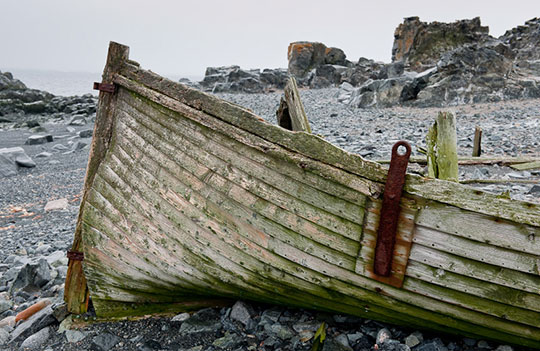
Boat Wreck – Half Moon Island, Antarctica. January, 2009
Nikon D3x with 24-70mm f/2.8 @ ISO 200
I don’t recall at the moment specifically what it was, but there was one point where I was shooting from a Zodiac and needed to change a setting, and for the life of me couldn’t remember where it was. A rubber boat bouncing in the Antarctic ocean with salt water spraying across the bow isn’t a time or place to break out the user manual, and several minutes of menu shuffling failed to turn up the needed screen. And this is after I’ve been using the D3 for more than a year having shot thousands of frames on an almost daily basis. This is not just Nikon’s fault – most cameras have simply become too damn complex for their own good, and ours.
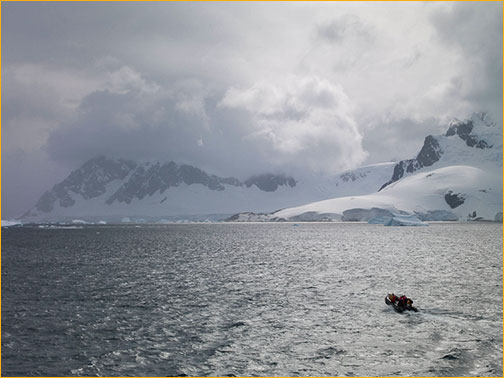
On The Zodiac – by Geoff Baehr
______________________________________________________________
Shooting Speed and Bit Depth
As mentioned earlier the D3x is capable of 5 FPS in 12 bit mode. This is the same shooting speed as the Sony A900 with a similar resolution chip. In 14 bit mode though the Nikon’s speed drops to below 2FPS.
The 21MP Canon 5D MKII can do 3.9 FPS in 14 bit mode, and doesn’t even offer a 12 bit mode.
The question then becomes, is 14 bit mode worthwhile using on the D3x? Does it offer a clear image quality advantage and is it therefore worth using unless high frame rates are needed?
The answer is a qualified yes. Frankly, in doing some informal tests with the same image in 12 bit and 14 bit modes, IthinkI can see a difference, but I might just be imagining it. When trying to extract maximum tonal separation on a difficult image the extra bit depth is almost certainly worthwhile, but after my initial tests, and for all of my shooting in Antarctica, I kept the camera in 12 bit mode, simply because in that situation I valued shooting speed over the nth degree of possible image quality. 1.8 FPS just isn’t enough for me in most situations, except for tripod based landscape work.
______________________________________________________________
Noise
Though I shot many hundreds of frames with the D3x I can’t say that I really properly put it though its paces during the period that I had it available. From a handling point of view it seemed to be a D3, which I was completely familiar with, and it was only when I’d sit and review files on my Macbook Pro in the evening that I’d be aware that I was shooting with a 25MP camera. But since I was also shooting with another 25MP camera, and a 60MP medium format back, nothing in the files seemed all that out of the ordinary.

Dx3 with 24-70mm @ ISO 1600
Most of my shooting was at ISO 800 or less, and so I really didn’t have an opportunity to put the D3x though its high ISO paces. Above though is a frame at ISO 1600, showingChris Sandersontrying out aCanon 5D MKIIequipped with an external mike and wind sock, at our hotel in Buenos Aires. Below is a 100% crop to give an idea of what the noise looks like at this speed.
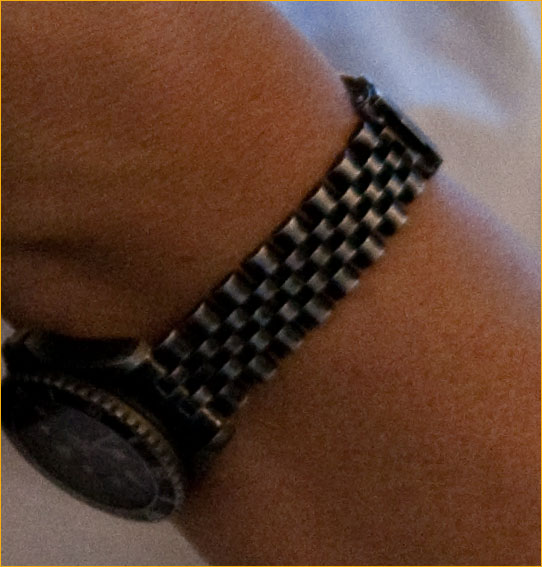
Dx3 with 24-70mm @ ISO 1600 – 100% detail crop
ISO 1600 noise is quite well controlled, subjectively comparable to other cameras in its class, such as the 1Ds MKIII and A900. Below is a comparison of the D3x, 1Ds MKIII and A900 from DxOMark. It shows that even at between ISO 2000 and 3000 the noise difference between these three cameras is less than 3db, which is visible, but below the point where it is significant.
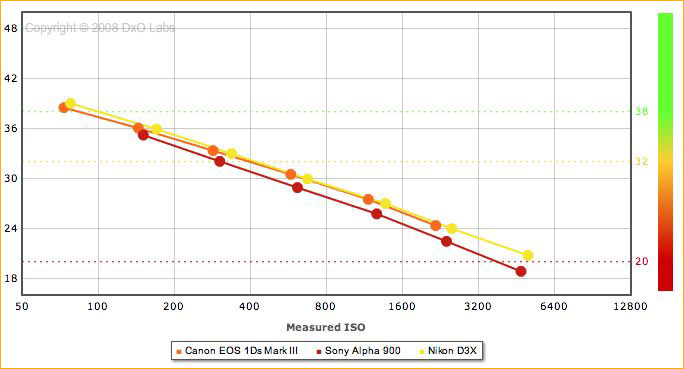
And just for the record, below is a graph from DxOMark showing the D3, D3x and the Canon 5DMKII. The D3x lags the D3, as is to be expected, but the Canon 5D MKII edges out the D3x by a full 6DB, which is significant. Not to diminish the fine performance of the D3x, but it is not the leader of the pack when it comes to low noise at high ISO, even in its resolution class.

Mid-Feb, 2009
UPDATE
The graphs shown above is a screen grab from the DxOMark web site
taken in mid-February when this article was first written.
I have been told (and indeed confirmed myself) that if you plot these cameras
today (March 2) on the DxO site the graphs will produce different results.
I have no explanation for this.
(Psst – The black helicopters are hovering overhead)
As always, do your own comparisons, don’t trust everything that you read,
even here, and seek multiple sources for confirmation.

March 2, 2009
______________________________________________________________
Numbers vs. Subjective Performance
Any camera has to be considered as a amalgam of its various characteristics and capabilities. To my mind, when you add up all of the factors the D3x is a class leader. But in virtually no individual area is it head and shoulders above the competition. There are cameras that match or exceed it in resolution, ones that have it beat in low noise and dynamic range, and others which equal it in build quality. But, when all the factors (except one) are blended together the D3x does come out near if not actually on top of the heap.
Not to flog a dead horse, but the real problem lies in its price. If the camera were priced comparably with its prime competitor, the Canon 1Ds MKIII, the issue wouldn’t be there. If the Sony A900 and Canon 5D MKII didn’t cost less than half as much we wouldn’t be talking about this. But it does and they do.
What we’re left with then is a superb camera that will appeal to the dedicated Nikon user who has been patiently waiting for Nikon to reemerge to its well-earned place as a leader in imaging technology. For them, as long as they can afford the price of admission, the D3x is an almost total winner. For others the price will mean a wait for a smaller, lighter and less expensive camera – one akin to the D700, which is a class leader in every respect. A D700x at a competitive price would take the world by storm, even in these hard economic times. But with the D3x’s sensor costing a $4,000 premium at this time it’s hard to see how a D700x is to be expected any time soon.
As for this whole generation of big-bodied cameras, the Nikon D3 series and the Canon 1 Series, something tells me that we may be seeing the end of an era. If Nikon can overcome the sensor price challenge and produce a competitive D700x, and Canon has the balls to move their 5D series upmarket in terms of build quality and features, it’ll all be over but the shouting. But then there’s now also Sony, who could be an industry spoiler in the months and years ahead. We’ll see.
March, 2009
You May Also Enjoy...
Shooting With The Masters – Charles Cramer Part 4
FacebookTweet Diving Into Printing The Masterfile As Charlie has explained and will continue to explain through the next three videos he makes use of a
2011 Lula Awards
At year-end it is a tradition in the media to issues awards –Man of the Year,Camera of the Year,News Event of The Year, and so


